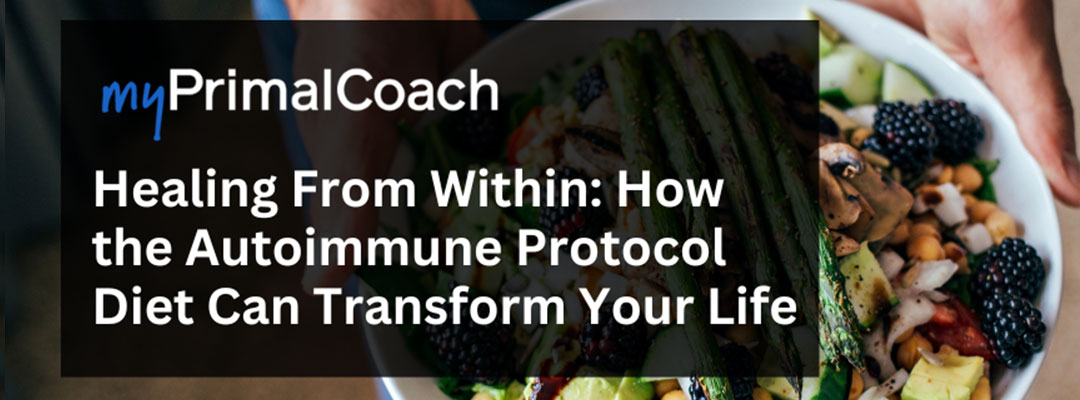The autoimmune protocol diet (AIP) is a specialized approach that can offer a beacon of hope for people battling autoimmune disease. Persistent fatigue, unexplained joint pain, frustrating digestive issues, and pervasive brain fog are all common realities of living with autoimmunity.

The autoimmune protocol diet aims to calm autoimmune flare-ups and promote healing.
An autoimmune disease is a condition where your body's normally protective immune system mistakenly identifies its own healthy tissues as foreign invaders. It then launches a subsequent attack. If you’re among the growing number dealing with autoimmunity, you may have come across the autoimmune protocol diet.
More than just a fad diet plan, the autoimmune protocol diet is a comprehensive dietary and lifestyle approach. It's specifically designed to combat inflammation, heal the gut lining, and ultimately help modulate your autoimmune activity.
The autoimmune protocol diet has garnered attention as a therapeutic dietary approach for several chronic digestive disorders including:
- Inflammatory Bowel Disease (IBD)
- Ulcerative Colitis
- Crohn's disease
If reducing inflammation and promoting gut healing is on your radar, then keep reading!
In this post we'll dive into the core tenets of the autoimmune protocol diet. We will explore its phases, the science behind it, and how it helps provide a path for identifying your food triggers.
What Is the Autoimmune Protocol Diet?
At its heart, the autoimmune protocol diet isn't just about what you eliminate. It's a strategy built on several principles that aim to calm autoimmune flare-ups and promote healing. In lieu of just masking symptoms, the diet is a targeted approach to addressing the key drivers of autoimmune disease.
The autoimmune protocol diet focuses on removing foods that cause inflammation, such as those found in our modern-day diet. Foods high in refined sugars, unhealthy fats (like industrial seed oils), and processed ingredients can trigger immune responses and exacerbate autoimmune symptoms. By eliminating these culprits, the diet aims to reduce the inflammatory load, allowing the body to calm down and begin to heal. The diet also strongly emphasizes nutrient density and encourages consuming foods rich in vitamins, minerals, and antioxidants that are essential for immune function and tissue repair.
The autoimmune protocol diet is rooted in healing the gut lining. It recognizes that a compromised gut barrier (colloquially known as "leaky gut") often plays a pivotal role in autoimmune conditions.
In a healthy gut, the lining acts as a tight barrier. It selectively allows nutrients to pass into the bloodstream while blocking harmful substances. However, certain foods and lifestyle factors can damage the lining and lead to increased permeability. When this occurs, undigested food particles, toxins, and microbes can "leak" into the bloodstream and trigger an immune response that contributes to systemic inflammation.
The protocol isn't just about what foods you consume. It also incorporates lifestyle modifications to reduce your body's inflammatory load and boost your healing capacity. These factors include:
- Prioritizing quality sleep.
- Stress management.
- Gentle movement at a low intensity.
Phases of the Autoimmune Protocol Diet
The autoimmune protocol diet is a phased protocol, not an eating plan you follow ad infinitum. The approach guides you through an elimination protocol followed by a reintroduction phase. The goal is to help figure out your unique food sensitivities and any potentially problematic foods.
Phase 1: The Diet Elimination Phase
This phase involves strictly removing all potentially inflammatory foods. The goal is to reduce inflammation levels and allow the gut time to heal. It typically takes 30 to 90 days, or until you experience significant and sustained improvement from symptoms. Strict adherence is absolutely crucial during this stage.
Phase 2: The Reintroduction Phase
Once symptoms have significantly improved, you reintroduce eliminated foods, one at a time, to identify your personal triggers. Only begin this phase after achieving a stable baseline of symptom improvement.
The Method Involves:
- Choose one food (such as egg yolk).
- Eat a very small test portion on day one.
- Observe for immediate reactions.
- If no reaction, eat a slightly larger portion later the same day.
- Follow with a three to seven day period of full elimination, monitoring for any delayed symptoms (fatigue, pain, digestive issues, etc.).
- If you react, the food is a "fail" for now, and you return to full elimination until symptoms stabilize. If no reaction, the food is likely tolerated and can be gradually reincorporated.
- Repeat the process for each new food.
The reintroduction phase can last several months, depending on how many foods you test.
Phase 3: The Maintenance Phase
This is your personalized, long-term diet that is built on the knowledge gained from reintroduction. You'll understand which foods you can tolerate and which you need to avoid to manage your autoimmune condition effectively.
Your maintenance diet will be unique to you, maximizing tolerated foods while minimizing symptom triggers. Autoimmune healing is dynamic, and it’s important to continue listening to your body and adjust as needed.
What to Eat (And Not to Eat) on the Autoimmune Protocol Diet
Embarking on an autoimmune protocol diet requires a significant shift in dietary habits. It stresses focusing on nutrient-dense, anti-inflammatory foods while eliminating those commonly associated with gut inflammation and immune activation. Understanding precisely what to include and what to avoid is foundational to the success of the elimination phase.
Foods to Eliminate
The autoimmune protocol diet elimination phase removes common inflammatory foods to support gut healing. Here's what to avoid, and why:
- Grains (All types):
- Why eliminated: Contain gluten and lectins that damage the gut and drive inflammation.
- Avoid: Wheat, barley, oats, rice, corn, quinoa, etc.
- Legumes:
- Why eliminated: High in gut-irritating lectins, saponins, and nutrient-blocking phytic acid.
- Avoid: Beans, lentils, chickpeas, soy products, peanuts.
- Dairy (All forms):
- Why eliminated: Lactose and dairy proteins can trigger inflammation
- Avoid: Milk, cheese, yogurt, kefir, butter, ghee (often reintroduced later).
- Nightshades:
- Why eliminated: Solanine and capsaicin in these foods may promote inflammation and gut issues.
- Avoid: Tomatoes, white potatoes, peppers, eggplant, goji berries, related spices (e.g., paprika). Tobacco is also a nightshade.
- Eggs:
- Why eliminated: Egg whites contain compounds that can increase gut permeability. Both whites and yolks are common allergens.
- Avoid: Whole eggs, yolks, whites, and egg-containing products.
- Nuts and Seeds:
- Why eliminated: Contain gut irritants and immune triggers.
- Avoid: All nuts, seeds, coffee, chocolate, and seed-based spices (e.g., cumin, mustard).
- Refined Sugars and Artificial Sweeteners:
- Why eliminated: Contribute to inflammation and disrupt gut flora.
- Avoid: White/brown sugar, HFCS, aspartame, sucralose, agave.
- Industrial Seed Oils:
- Why eliminated: High in pro-inflammatory omega-6 fatty acids, processed with harsh chemicals.
- Avoid: Canola oil, sunflower oil, safflower oil, soybean oil, corn oil, cottonseed oil, grapeseed oil.
- Alcohol:
- Why eliminated: Disrupts gut integrity, strains the liver, and can trigger inflammatory responses.
- Avoid: All alcoholic beverages.
- NSAIDs (Non-Steroidal Anti-Inflammatory Drugs):
- Why eliminated (as much as possible, under doctor's guidance): Can damage the gut lining. Avoid: Ibuprofen, naproxen.
- Food Additives:
- Why eliminated: Can disrupt gut health and trigger immune responses.
- Avoid: Gums (guar, xantham), carrageenan, artificial flavors/colors, emulsifiers.
Foods to Focus On
The autoimmune protocol diet centers around nutrient-dense, anti-inflammatory foods that support gut healing and immune regulation:
- Pasture-Raised Meats & Poultry:
- Rich in protein, iron, B vitamins, and omega-3s.
- Examples: Beef, lamb, pork, chicken, turkey, and duck.
- Wild-Caught Fish & Seafood:
- High in anti-inflammatory omega-3s (EPA/DHA), protein, and minerals.
- Examples: Salmon, mackerel, sardines, cod, tuna (moderation), shrimp, scallops.
- Organ Meats:
- Nutritional powerhouses, especially rich in vitamins A, B12, iron, and enzymes.
- Examples: Liver, heart, kidney, tongue.
- Non-Nightshade Vegetables:
- Provide fiber, antioxidants, and essential nutrients.
- Examples: Leafy greens, cruciferous veggies, carrots, sweet potatoes, squash, zucchini, mushrooms, onions, garlic.
- Fermented Foods:
- Supply probiotics to support gut microbiome health.
- Examples: Sauerkraut, kimchi, coconut kefir, kombucha. Be sure to check labels for added sugar or prohibited ingredients.
- Healthy Fats:
- Needed for hormone balance, brain health, and nutrient absorption.
- Examples: Avocado, olive oil, coconut oil, pasture-raised animal fats.
- Bone Broth:
- Heals the gut lining and supports joints with collagen, gelatin, and amino acids.
- Examples: Homemade chicken, beef, or fish broth.
- Non-Seed Herbs & Spices:
- Add flavor and anti-inflammatory benefits.
- Examples: Turmeric, ginger, cinnamon, basil, rosemary, thyme, parsley, cilantro.
- Low-Sugar Fruits:
- Offer vitamins, antioxidants, and fiber.
- Examples: Berries, apples, pears, melons, bananas.
Does The Autoimmune Protocol Diet Align With a Primal Diet?
Short answer? Absolutely!
The autoimmune protocol diet is often described as an intensified version of the paleo diet, and is deeply aligned with Primal eating principles.
Both diets emphasize whole, unprocessed foods such as quality meats, fish, fruits, and most vegetables while excluding grains, legumes, processed foods, and refined sugars. However, the autoimmune protocol diet goes further by also removing Primally-aligned foods such as eggs, nightshades, nuts, and seeds—but only for a short period of time.
Many people with autoimmunity find success with a personalized AIP-Primal hybrid way of eating.
Summary
While demanding, the autoimmune protocol diet offers a great opportunity for individuals dealing with autoimmune conditions. Its benefits can be transformative and lead to significantly reduced inflammation, pain, improved gut health and digestion, and a noticeable increase in energy. For many, the ultimate reward is a substantial reduction (even remission) of autoimmune symptoms.
However, it's essential to acknowledge the challenges of taking this path. The diet is initially very restrictive. It demands considerable meal planning and cooking, and can present social hurdles. Above all, it requires immense patience and consistency. Despite these difficulties, for those committed, the AIP diet is a powerful tool toward reclaiming health.
It is crucial to consult with a healthcare professional before beginning the autoimmune protocol diet. They can help determine if it's the right approach for patients with your specific condition.
If you’re curious about embarking on an autoimmune protocol diet, a myPrimalCoach can guide you through the phases and help you map out your personalized diet and nutrition plan.
